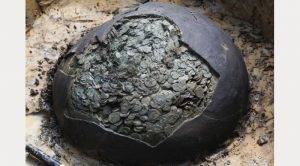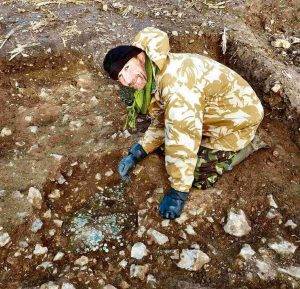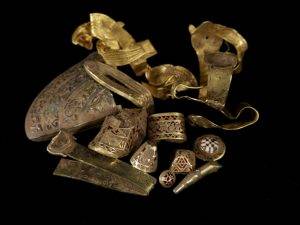3 Of The Largest Treasure Hoards Found By Metal Detectors In The UK
Striking a massive hoard is the dream of most detectorists. After all, detecting such a hoard is a life-changing event and typically the results of many years of searching. For the three detectorists detailed below that dream became a reality. Here we will look at 3 Of The Largest Hoards Found By Metal Detectors in the UK. These hoards are fascinating both for the way that they were detected and the stories and secrets uncovered by those hidden treasures.
The Frome Hoard
 In late April of 2012 metal detectorist Dave Crisp made the discovery of a lifetime. His attention was first caught when he detected what he now refers to as an “iffy” signal. He dug down and the signal could still be heard. Digging even deeper, until he was twelve to fourteen inches deep into the ground, he put his hand into the ground he pulled out a black object.
In late April of 2012 metal detectorist Dave Crisp made the discovery of a lifetime. His attention was first caught when he detected what he now refers to as an “iffy” signal. He dug down and the signal could still be heard. Digging even deeper, until he was twelve to fourteen inches deep into the ground, he put his hand into the ground he pulled out a black object.
At first, he thought he had pulled from the ground a rock but he soon realized that what he had in his hand looked like a piece of Roman pottery. Putting his hand on the ground again he pulled out a small bronze Roman coin only the size of a fingernail. It was then Crisp realized that what he had discovered was a hoard. Despite the fact that Crisp had been a detectorist for twenty-two years he had never encountered a hoard until this weekend.
Initially, experts had no idea exactly how large a hoard they were dealing with. It was only upon determining that they the pottery that Crisp had encountered was the top of a lid of an enormous vessel that the full size of the hoard became apparent. It took archaeologists a full two days to excavate the hoard of thousands upon thousands of coins. Because Crisp alerted archaeologists to the find immediately there is now a much greater chance of determining why the hoard was buried in the ground so many years ago.
The Frome Hoard was composed of 52,503 Roman coins that date from AD 253 to 305. Even more importantly the majority of the coins were made from silver or bronze. One of the most important features of this hoard was that it was ground coins issue by Carausius who rule Britain between 286 and 293. This was the first Roman Emperor to strike coins in Britain. The hoard has been valued at £320,250.
The Seaton Down Hoard
 In November 2013 Laurence Egerton, a fifty one year semi-retired builder from East Devon, found two ancient coins approximately the size of thumbnail in a field using his metal detector. Upon digging deeper his shovel pulled up from the ground covered in copper alloy coins. Egerton was stunned by his discovery as he had never seen so many coins in one place before. Egerton was quick to call in the experts and watched as archaeologists pulled from the ground thousands of more coins. To ensure the security of his find Mr Egerton slept in his car watching over his find.
In November 2013 Laurence Egerton, a fifty one year semi-retired builder from East Devon, found two ancient coins approximately the size of thumbnail in a field using his metal detector. Upon digging deeper his shovel pulled up from the ground covered in copper alloy coins. Egerton was stunned by his discovery as he had never seen so many coins in one place before. Egerton was quick to call in the experts and watched as archaeologists pulled from the ground thousands of more coins. To ensure the security of his find Mr Egerton slept in his car watching over his find.
The hoard that Egerton had discovered turned out to be one of the most important finds in UK history. Archaeologists on the scene quickly determined the importance and quality of the coins that were being discovered. Once they had been cleaned, identified and cataloged by the British Museum it was discovered that they ranged from AD 260 to AD 350 and bore a range of portraits from the House of Constantine.
The British Museum has called the hoard remarkable pointing out that its one of the largest hoard ever found within the whole Roman empire. In total there were about 22,000 coins making it the fifth largest find of Roman coins in Britain. The proceeds of the hoard which is valued at approximately £100,000 was split between Egerton and the landowner of Clinton Devon Estates.
The Staffordshire Hoard
 The Staffordshire Hoard is the largest hoard of Anglo-Saxon gold that has ever been discovered. The hoard was discovered by a detectorist in a field in the village of Hammerwich, located in Staffordshire England in July 2009. The hoard is comprised of 3,500 items that are virtually all military in nature. The artifacts have been dated to between the 7th and 8th centuries and arise from the Anglo Saxon kingdom of Mercia. The quality of the workmanship from the Staffordshire Hoard is very high and is valued at approximately £3,285 million.
The Staffordshire Hoard is the largest hoard of Anglo-Saxon gold that has ever been discovered. The hoard was discovered by a detectorist in a field in the village of Hammerwich, located in Staffordshire England in July 2009. The hoard is comprised of 3,500 items that are virtually all military in nature. The artifacts have been dated to between the 7th and 8th centuries and arise from the Anglo Saxon kingdom of Mercia. The quality of the workmanship from the Staffordshire Hoard is very high and is valued at approximately £3,285 million.
One of the most interesting secrets revealed from the Staffordshire hoard was that craftsmen in Anglo Saxon Mercia used a technique to give lower grade metal the appearance of pure gold. There are no written records of this technique from Anglo-Saxon time and it has never before been detected in metalwork from this period. The technique involved using gold which was then alloyed with up to 25% silver. These metals were then heated in an acid solution so that at the surface the silver could be leached out and burnished off. The surface would have the appearance of high-quality gold but sitting just under the surface would be the lower quality metal.
The Staffordshire Hoard was discovered by Terry Herbert when he was searching an area of farmland near Hammerwich with his metal detector. His discovery produced enough gold objects that over the next five days he was able to fill 244 bags. Herbert reached out to the local Finds Liaison Officer for Staffordshire. The owner of the land Mr Fred Johnson then gave permission for the rest of the hoard to be excavated. Because of plowing the artifacts had been scattered across a wide area. In total, an area of 9 by 13 meters would be excavated during the search.
When the hoard was displayed at the Birmingham Museum & Art Gallery it attracted more than 40,000 people. In 2012 an additional ninety-one items of silver and gold metalwork were removed from the same field as the Staffordshire Hoard. While many of the pieces were less than one gram in weight there was also larger pieces discovered including both eagle and cross-shaped mount. The Staffordshire Hoard is now on permanent display at the Birmingham Museum and at the Potteries Museum. If you would like to take a further look at the Staffordshire Hoard in all it’s glory, it has it’s own dedicated website here.
While all of these hoards were spectacular discoveries there is almost certainly other treasures waiting to be unlocked. It is interesting to note that each of these discoveries was the fruits of committed detectorists who had spent years searching for just such a find. Their commitment paid off both in the discovery of a lifetime and an enriched understanding of our ancestor’s lives.
